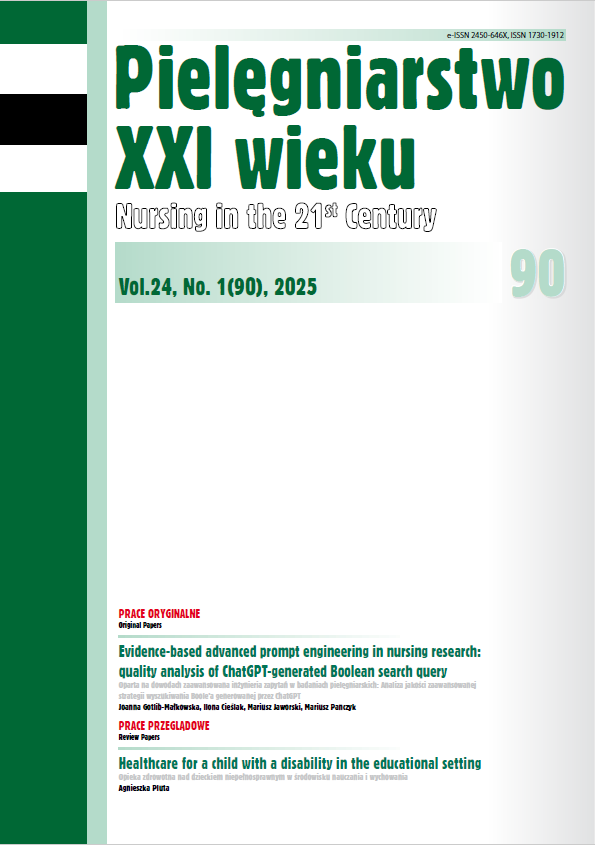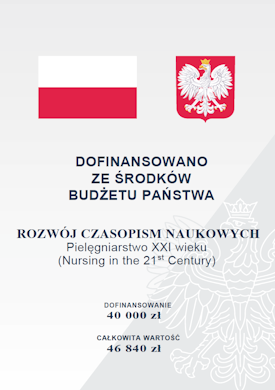Post intensive care syndrome in paediatrics PICS-p: symptoms, severity and prevalence
DOI:
https://doi.org/10.12923/pielxxiw-2025-0010Keywords:
cognitive impairment, physical impairment, post‐intensive care syndrome, mental impairment, PICS‐pAbstract
POST INTENSIVE CARE SYNDROME IN PAEDIATRICS PICS-p: SYMPTOMS, SEVERITY AND PREVALENCE
Introduction. Interest in post-intensive care syndrome – pediatrics (PICS-p) has been relatively recent. It is described by dysfunctions in the physical, mental, cognitive and social spheres persisting months or even years after discharge from the intensive care unit (ICU).
Aim. The aim of this study is to compile the available data on post-intensive care syndrome in children treated in the ICU and introducing nurses and midwives to the relatively new topic of PICS-p in a synthetic and accessible way.
Method. A literature review was conducted using the PubMed database. The key words used included: post‐intensive care syndrome paediatric, PICS‐p, cognitive impairment, mental impairment, physical impairment, child, PICU.
Conclusions. Due to variations in the studies, the research tools used and the variables considered, it is difficult to determine the exact prevalence of the phenomenon. Motor dysfunction is observed in 15%-65% of children following ICU discharge, cognitive dysfunction is observed in 9%-50% of subjects, and psychiatric symptoms are present in 13%-40% of children. Further research is needed to understand PICS-p more comprehensively, to find ways to prevent it, for a rapid and reliable diagnosis standardized in terms of the tools used, and for its comprehensive management.
References
1. Manning JC, Pinto NP, Rennick JE, et al. Conceptualizing post intensive care syndrome in children - The PICS-p framework. Pediatric Critical Care Medicine. 2018; 19(4): 298-300. https://doi.org/10.1097/PCC.0000000000001476.
2. Rennick JE, Dougherty G, Chambers C, et al. Children’s psychological and behavioral responses following pediatric intensive care unit hospitalization: the caring intensively study. BMC Pediatr. 2014; 14(1): 1-11. https://doi.org/10.1186/1471-2431-14-276.
3. Pollack MM, Holubkov R, Funai T, et al. Pediatric intensive care outcomes: development of new morbidities during pediatric critical care. Pediatr. Crit. Care Med. 2014; 15(9): 821. https://doi.org/10.1097/PCC.0000000000000250.
4. Burns JP, Sellers DE, Meyer EC, et al. Epidemiology of death in the Pediatric Intensive Care Unit at Five U.S. Teaching Hospitals. Crit. Care Med. 2014; 42(9): 2101. https://doi.org/10.1097/CCM.0000000000000498.
5. Ibiebele I, Algert CS, Bowen JR, et al. Pediatric admissions that include intensive care: a population-based study. BMC Health Serv. Res. 2018; 18(1): 264. https://doi.org/10.1186/s12913-018-3041-x.
6. Herrup EA, Wieczorek B, Kudchadkar SR. Characteristics of postintensive care syndrome in survivors of pediatric critical illness: A systematic review. World J. Crit. Care Med. 2017; 6(2): 124-134. https://doi.org/10.5492/wjccm.v6.i2.124.
7. Gajic O, Ahmad SR, Wilson ME, et al. Outcomes of critical illness: What is meaningful? Curr. Opin. Crit Care. 2018; 24(5): 394-400. https://doi.org/10.1097/MCC.0000000000000530.
8. Rawal G, Yadav S, Kumar R. Post-intensive care syndrome: an overview. J. Transl. Int. Med. 2017; 5(2): 90-92. https://doi.org/10.1515/jtim-2016-0016.
9. Balas M, Buckingham R, Braley T, et al. Extending the ABCDE bundle to the post-intensive care unit setting. J. Gerontol. Nurs. 2013; 39(8): 39-51. https://doi.org/10.3928/00989134-20130530-06.
10. Tippayawong P, Chaiyakulsil C. Incidence and associated factors of pediatric post-intensive care syndrome using the VSCAREMD model. Acute and Critical Care. 2022; 37(4): 627-635. https://doi.org/10.4266/acc.2022.00234.
11. Sankar J, Moodu S, Kumar K, et al. Functional Outcomes at 1 Year After PICU discharge in critically ill children with severe sepsis. Pediatr. Crit. Care Med. 2021; 22(1): 40-49. https://doi.org/10.1097/PCC.0000000000002592.
12. Pollack MM, Banks R, Holubkov R, et al. Long-Term outcome of picu patients discharged with new, functional status morbidity. Pediatr. Crit Care Med. 2021; 22(1): 27-39. https://doi.org/ 10.1097/PCC.0000000000002590.
13. Farris RWD, Weiss NS, Zimmerman JJ. Functional outcomes in pediatric severe sepsis; further analysis of the RESOLVE Trial. Pediatr. Crit. Care Med. 2013; 14(9): 835-842. https://doi.org/10.1097/PCC.0b013e3182a551c8.
14. Bennett TD, Dixon RR, Kartchner C, et al. Functional status scale in children with traumatic brain injury: a prospective cohort study. Pediatr Crit Care Med. 2016; 17(12): 1147-1156. https://doi.org/10.1097/PCC.0000000000000934.
15. Pollack MM, Holubkov R, Glass P, et al. The functional status score (fss): a new pediatric outcome measure. Pediatrics. 2009; 124(1): e18-28. https://doi.org/10.1542/peds.2008-1987.
16. Pollack MM, Holubkov R, Funai T, et al. Relationship between the functional status scale and the pediatric overall performance category and pediatric cerebral performance category scales FREE. JAMA Pediatr. 2014; 168(7): 671-676. https://doi.org/10.1001/jamapediatrics.2013.5316.
17. Inoue S, Hatakeyama J, Kondo Y, et al. Post‐intensive care syndrome: its pathophysiology, prevention, and future directions. Acute Medicine & Surgery. 2019; 6(3): 233-246. https://doi.org/10.1002/ams2.415.
18. Watson RS, Asaro LA, Hutchins L, et al. Risk factors for functional decline and impaired quality of life after pediatric respiratory failure. Am. J. Respir. Crit. Care Med. 2019; 200(7): 900-909. https://doi.org/10.1164/rccm.201810-1881OC.
19. Johnson RW, Ng KWP, Dietz AR, et al. Muscle atrophy in mechanically-ventilated critically ill children. PLoS One. 2018; 13(12): e0207720. https://doi.org/10.1371/journal.pone.0207720.
20. Knoester H, Bronner MB, Bos AP, et al. Quality of life in children three and nine months after discharge from a paediatric intensive care unit: a prospective cohort study. Health Qual Life Outcomes. 2008; 6:21. https://doi.org/10.1186/1477-7525-6-21.
21. Knoester H, Bronner MB, Bos AP. Surviving pediatric intensive care: physical outcome after 3 months. Intensive Care Med. 2008; 34(6): 1076-1082. https://doi.org/10.1007/s00134-008-1061-4.
22. Williams CN, Kirby A, Piantino J. If you build it, they will come: initial experience with a multi-disciplinary pediatric neurocritical care follow-up clinic. Children. 2017; 4(9): 83. https://doi.org/10.3390/children4090083.
23. Hopkins RO, Choong K, Zebuhr CA, et al. Physical therapy and rehabilitation in pediatric critical care: transforming PICU culture to facilitate early rehabilitation. J. Pediatr. Intensive Care. 2015; 4(4): 204-211. https://doi.org/10.1055/s-0035-1563547.
24. Wieczorek B, Ascenzi J, Kim Y, et al. PICU Up!: Impact of a quality improvement intervention to promote early mobilization in critically ill children. Pediatr. Crit. Care Med. 2016; 17(12): e559-e566. https://doi.org/10.1097/PCC.0000000000000983.
25. Wieczorek B, Burke C, Al-Harbi A, et al. Physical therapy and rehabilitation in pediatric critical care: early mobilization in the pediatric intensive care unit: a systematic review. J. Pediatr. Intensive Care. 2015; 4(4): 129-170. https://doi.org/10.1055/s-0035-1563386.
26. Maddux AB, Pinto N, Fink EL, et al. Post-discharge outcome domains in pediatric critical care and the instruments used to evaluate them: a scoping review. Crit. Care Med. 2020; 48(12): e1313-e1321. https://doi.org/10.1097/CCM.0000000000004595.
27. LaBuzetta JN, Rosand J, Vranceanu AM. Review: post-intensive care syndrome: unique challenges in the neurointensive care unit. Neurocrit. Care. 2019; 31(3): 534-545. https://doi.org/10.1007/s12028-019-00826-0.
28. Als LC, Tennant A, Nadel S, et al. Persistence of neuropsychological deficits following pediatric critical illness. Crit. Care Med. 2015; 43(8): e312-315. https://doi.org/10.1097/CCM.0000000000001075.
29. Watson RS, Beers SR, Asaro LA, et al. Association of acute respiratory failure in early childhood with long-term neurocognitive outcomes. JAMA. 2022; 327(9): 836-845. https://doi.org/10.1001/jama.2022.1480.
30. Meert K, Slomine BS, Silverstein FS, et al. One-year cognitive and neurologic outcomes in survivors of paediatric extracorporeal cardiopulmonary resuscitation. Resuscitation. 2019; 139: 299-307. https://doi.org/10.1016/j.resuscitation.2019.02.023.
31. Als LC, Nadel S, Cooper M, et al. Neuropsychologic function three to six months following admission to the PICU with meningoencephalitis, sepsis, and other disorders: a prospective study of school-aged children. Crit. Care Med. 2013; 41(4): 1094-1103. https://doi.org/10.1097/CCM.0b013e318275d032.
32. Als LC, Picouto MD, Hau SM, et al. Mental and physical well-being following admission to pediatric intensive care. Pediatr. Crit Care Med. 2015;16(5):e141-e149. https://doi.org/10.1097/PCC.0000000000000424.
33. Colville G, Pierce C. Patterns of post-traumatic stress symptoms in families after paediatric intensive care. Intensive Care Med. 2012; 38(9):1523-1531. https://doi.org/10.1007/s00134-012-2612-2.
34. Nelson LP, Lachman SE, Li SW, et al. The Effects of family functioning on the development of posttraumatic stress in children and their parents following admission to the pediatric intensive care unit. Pediatr. Crit Care Med. 2019; 20(4): e208-e215. https://doi.org/10.1097/PCC.0000000000001894.
35. Wade DM, Howell DC, Weinman JA, et al. Investigating risk factors for psychological morbidity three months after intensive care: a prospective cohort study. Crit Care. 2012; 16(5): R192. https://doi.org/10.1186/cc11677.
36. Long AC, Kross EK, Davydow DS, et al. Posttraumatic stress disorder among survivors of critical illness: creation of a conceptual model addressing identification, prevention, and management. Intensive Care Med. 2014; 40(6): 820-829. https://doi.org/10.1007/s00134-014-3306-8.
37. Jones C, Bäckman C, Capuzzo M, et al. Intensive care diaries reduce new onset post traumatic stress disorder following critical illness: a randomised, controlled trial. Crit Care. 2010; 14(5): R168. https://doi.org/10.1186/cc9260.
38. McGiffin JN, Galatzer-Levy IR, Bonanno GA. Is the intensive care unit traumatic? What we know and don’t know about the intensive care unit and posttraumatic stress responses. Rehabil. Psychol. 2016; 61(2): 120-131. https://doi.org/10.1037/rep0000073.
39. Davydow DS, Gifford JM, Desai S V, et al. Posttraumatic stress disorder in general intensive care unit survi-vors: a systematic review. Gen. Hosp. Psychiatry. 2008; 30(5): 421-434. https://doi.org/10.1016/j.genhosppsych.2008.05.006.
Downloads
Published
Issue
Section
License
Copyright (c) 2025 Patrycja Krystyna Mazurek, Anna Aftyka (Autor)

This work is licensed under a Creative Commons Attribution 4.0 International License.




